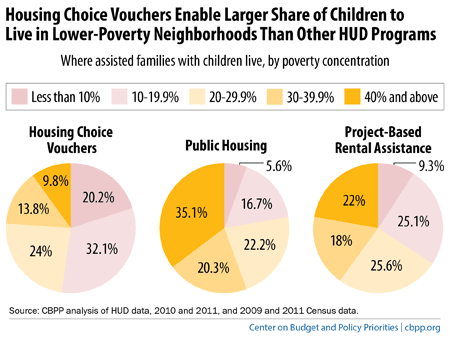BEYOND THE NUMBERS
Where children grow up can influence their lifelong health and success, and improvements to federal rental assistance programs could substantially better their life outcomes, our new report explains.
Nearly 4 million children live in families that receive federal rental assistance. But just 15 percent of the kids whose families receive rent subsidies through the Department of Housing and Urban Development’s (HUD) three major rental assistance programs — the Housing Choice Voucher (HCV) program, public housing, and Section 8 Project-Based Rental Assistance — live in high-opportunity neighborhoods with access to good schools, safe streets, and high rates of employment. A larger share (18 percent) of children in assisted families live in neighborhoods of extreme poverty, where at least 40 percent of the residents are poor.
Children exposed to neighborhood violence and extreme poverty often suffer cognitive, health, and academic deficiencies, research shows, while low-income children who can move to safer neighborhoods with better schools have experienced significant improvements in their lives, including gains in academic performance.
Over several decades, policymakers have tried to reduce the extent to which low-income families receiving federal rental assistance are concentrated in distressed neighborhoods and, instead, to improve these families’ access to higher-opportunity neighborhoods. To do so, they’ve relied increasingly on housing vouchers (rather than housing projects) so that families may choose where to live.
The HCV program has performed much better than HUD’s project-based rental assistance programs in enabling more low-income families with children to live in lower-poverty neighborhoods (see chart). Having a housing voucher also substantially reduces the likelihood of living in an extreme-poverty neighborhood.

Nevertheless, a quarter of a million children in the HCV program live in these troubled neighborhoods. As now administered, the HCV program doesn’t adequately deliver on its potential to expand children’s access to good schools in safe neighborhoods.
Based on the evidence on how housing location affects low-income families, particularly children, and federal rental assistance programs’ performance on location-related measures, we recommend two near-term goals: 1) federal rental assistance programs should provide greater opportunities for families to choose affordable housing outside of extreme-poverty neighborhoods; and 2) the programs should provide better access for families to low-poverty, safe communities with better-performing schools.
We can make substantial progress toward these goals in the next few years, even in the current fiscally constrained environment and without congressional action or more funding.
Federal, state, and local agencies can take four key actions to help more families in the HCV program to live in better locations:
- Create stronger incentives for local and state housing agencies to help families move to better neighborhoods.
- Modify policies that discourage families from living in higher-opportunity communities.
- Minimize jurisdictional barriers to families’ ability to choose to live in high-opportunity communities through the HCV program.
- Better assist families in using vouchers to live in high-opportunity areas.
Click here to read the full report.
